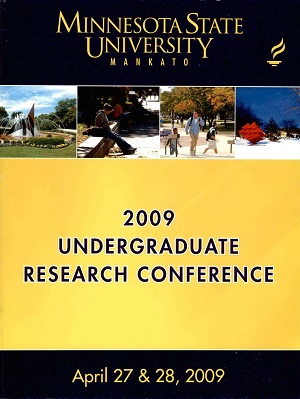The Impacts of Restored Wetlands and Ravines on Water Quality within the Seven Mile Creek Watershed in South Central Minnesota
Location
CSU Ballroom
Start Date
28-4-2009 10:00 AM
End Date
28-4-2009 12:00 PM
Student's Major
Biological Sciences
Student's College
Science, Engineering and Technology
Mentor's Name
Beth Proctor
Mentor's Department
Biological Sciences
Mentor's College
Science, Engineering and Technology
Description
Seven Mile Creek has a 23,551-acre watershed located in the Middle Minnesota River Basin in South Central Minnesota. Cultivated land covers 86% of the watershed. Historic maps and surveys indicate that 50% of Seven Mile Creek watershed was formerly covered in wetlands. Eighty-eight percent of those wetlands have been converted to cropland. In addition, miles of public and private drainage ditches, which feed into Seven Mile Creek, have been installed. Wetlands, once previously abundant in this area, provide natural filters, often releasing water of much higher quality than that which flowed into them. This study set out to test the water quality upstream and downstream from a restored wetland in the watershed, as well as at the top and bottom of the Seven Mile Creek ravine. The water quality parameters monitored were nitratesnitrites, total phosphorus, ortho phosphorus, total suspended solids, total suspended volatile solids, temperature, and conductivity. Water samples were taken during pre- and early-spring snowmelt, as well as during any storm events. The goal of the research was to quantify the changes in water quality caused by restored wetland and ravine in order to provide recommendations as to whether widespread wetland restoration would be advisable in the watershed, and/or if other management techniques should be considered.
The Impacts of Restored Wetlands and Ravines on Water Quality within the Seven Mile Creek Watershed in South Central Minnesota
CSU Ballroom
Seven Mile Creek has a 23,551-acre watershed located in the Middle Minnesota River Basin in South Central Minnesota. Cultivated land covers 86% of the watershed. Historic maps and surveys indicate that 50% of Seven Mile Creek watershed was formerly covered in wetlands. Eighty-eight percent of those wetlands have been converted to cropland. In addition, miles of public and private drainage ditches, which feed into Seven Mile Creek, have been installed. Wetlands, once previously abundant in this area, provide natural filters, often releasing water of much higher quality than that which flowed into them. This study set out to test the water quality upstream and downstream from a restored wetland in the watershed, as well as at the top and bottom of the Seven Mile Creek ravine. The water quality parameters monitored were nitratesnitrites, total phosphorus, ortho phosphorus, total suspended solids, total suspended volatile solids, temperature, and conductivity. Water samples were taken during pre- and early-spring snowmelt, as well as during any storm events. The goal of the research was to quantify the changes in water quality caused by restored wetland and ravine in order to provide recommendations as to whether widespread wetland restoration would be advisable in the watershed, and/or if other management techniques should be considered.
Recommended Citation
Langer, Caitlin. "The Impacts of Restored Wetlands and Ravines on Water Quality within the Seven Mile Creek Watershed in South Central Minnesota." Undergraduate Research Symposium, Mankato, MN, April 28, 2009.
https://cornerstone.lib.mnsu.edu/urs/2009/poster-session-C/17



